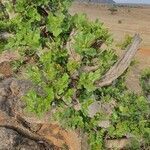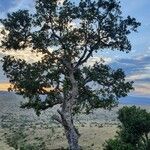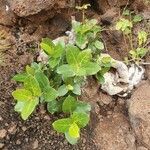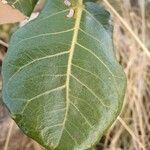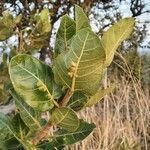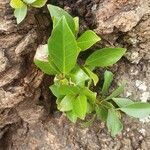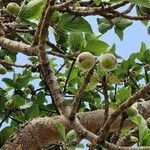Leaves spirally arranged; lamina oblong to broadly elliptic or broadly ovate, sometimes obovate or subcircular, 2–14(19) x 1.2–9.5(13) cm., subcoriaceous; apex shortly acuminate to subacute or subobtuse; base cordate, sometimes rounded; margin entire; superior surface puberulous, hirtellous or subtomentose, sometimes almost glabrous, inferior surface subtomentose, main veins yellow hirsute or glabrous; lateral veins 3–7 pairs, the basal pair faintly branched, usually ending at the margin far below the middle of the lamina, or sometimes at or above the lamina middle, tertiary venation reticulate or tending to scalariform, the smaller veins (reticulum) inconspicuous beneath; petiole 0.5–4(8) cm. long, 1–2(2.5) mm. thick, epidermis not flaking off; stipules 5–15 mm. long, up to 40 mm. long on new flush, caducous, partly or ± sparsely hirsute to subsericeous, the indumentum bright yellow or sometimes whitish.
A fig. It is a shrub or tree. It loses its leaves during the year. It grows up to 10-15 m tall. It has spreading branches. It can spread 12 m wide. The bark is smooth and a grey-green. It has a few rough flaky pieces. The young shoots are hairy white. The leaves are soft and pink when young but stiff and papery when mature. They are long and oval. They are 2.5-10 cm long. The tip is rounded but with a sharp point. The base of the leaf is heart shaped. The leaf stalk is 4 cm long and thick and wavy. The leaves are hairy underneath except in one variety. The fruit are figs which are round and in pairs. They have fine silky hairs. They grow in the axils of leaves and are 7 cm across. They are green but turn red as they ripen. They are sweet and succulent.
Tree, 4-10 m high, rock-splitter, rarely terrestrial. Main stem short, crooked; bark whitish to yellowish green, smooth or flaking; branchlets densely hairy. Leaves alternate, stiff, round-oblong to broadly elliptic (30-140 x 16-95 mm), thickly textured, dark green glossy above, densely hairy when young, base lobed to rounded, apex rounded; petioles 5-50 mm long, hairy; stipules large and prominent on new growth, up to 50 mm long, densely hairy. Syconia (figs) single or in pairs in leaf axils, stalkless, ± rounded, 8-15 mm in diam., densely to sparsely hairy, pink or red when ripe; ostiole often raised, yellowish.
Tree, up to 10 m high. Leaves broadly ovate to elliptic, apex rounded to bluntly acute, margin entire but often wavy, permanently hairy beneath, becoming smooth with age above. Figs sessile, up to 15 mm in diameter, red with white markings.
Receptacle globose to ellipsoid, c. 1–1.5 cm. in diam. when fresh, 0.5–1 cm. in diam. when dry, densely tomentose to pubescent or almost glabrous, orange to red or pink at maturity, often with darker spots.
Leafy twigs 2–6 mm. thick, indumentum dense, of short white hairs intermixed with much longer yellow to whitish hairs especially on the nodes, or glabrous; periderm of older parts flaking off when dry.
Figs in pairs in the leaf axils or 0–10 mm below the leaves, subsessile or sometimes on peduncles up to 3 mm. long; basal bracts c. 3 mm. long, persistent.
Trees up to 10 m. tall or shrubs, terrestrial, branches spreading.
